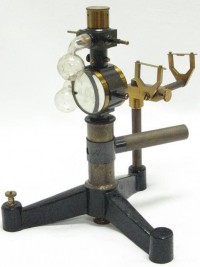By Hamish Johnston
Last week I promised readers a genuine mystery – and here it is. Do you know what this piece of apparatus was used for?
It currently resides in the McPherson Collection of physics instruments at McGill University in Montreal and its purpose has long puzzled curator Jean Barrette – who I spoke to when I was in Canada recently.
The device looks like it is designed for bench-top use and Barrette believes that it was used to study gases. Inside the cylindrical section with the half-moon window there is another small cylindrical part that can move. The small cylindrical extension to the right of the main component is an electrode input to bring high voltage inside the chamber.
“Any idea on the purpose of the instrument would be greatly appreciated,” said Barrette.
There must be a physicsworld.com reader out there who knows what this is. Please let Jean and I know by leaving a comment below.

this book
Spectrum Analysis: Six Lectures, Delivered in 1868, Before the Society of …
By Henry Enfield Roscoe
books.google.ca/books?id=4wY6AQAAIAAJ
explains the state of the art of Spectrum Analysis of gases in the 19th century – I like the apparatus on page 117.
This old science journal explains how metals were examined
Spectra of the metalloids
http://books.google.ca/books?id=15wEAAAAYAAJ&dq=gas%20spectrum%20machine&pg=PA178#v=onepage&q=gas%20spectrum%20machine&f=false
http://books.google.ca/books?id=15wEAAAAYAAJ&dq=gas%20spectrum%20machine&pg=PA178#v=onepage&q&f=false
the section on Tellurium on page 178-179 describes metals heated in a vacuum tube and the spectrum being looked at.
My guess would be an early way of measuring the specific rotation of a gas (polarimeter) and the two holders on the stem could be for polarising filters, plus they look like they can be rotated. That said I would have thought there would have to be one filter on either side of the central chamber for that to be true.
Also, colleges kept a catalog of thier lab equipment in the 19th century. The equipment is likely listed in the 1899 McGill catalog – check the library for this book: http://books.google.ca/books?id=RH0iAQAAMAAJ&q=mcgill+spectrometer&dq=mcgill+spectrometer&hl=en&sa=X&ei=8ha0Ua6NL6mrjAKL_ICABw&ved=0CDkQ6AEwAA
This is a very accurate goldleaf electroscope. the glass bulbs would have held anhydrous cobalt chloride and the two brass clamps would have held a viewing telescope. They ere used to determine very small changes in electrostatic fields. Any more unusual instruments??